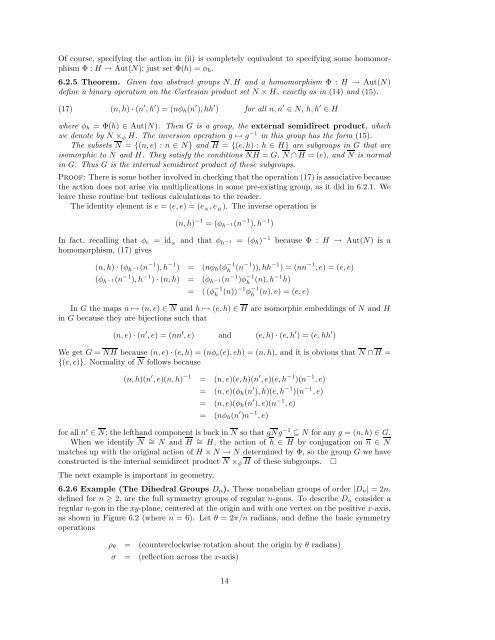Algebra I: Section 6. The structure of groups. 6.1 Direct products of ...
Algebra I: Section 6. The structure of groups. 6.1 Direct products of ...
Algebra I: Section 6. The structure of groups. 6.1 Direct products of ...
You also want an ePaper? Increase the reach of your titles
YUMPU automatically turns print PDFs into web optimized ePapers that Google loves.
Of course, specifying the action in (ii) is completely equivalent to specifying some homomorphism<br />
Φ : H → Aut(N); just set Φ(h) = φh.<br />
<strong>6.</strong>2.5 <strong>The</strong>orem. Given two abstract <strong>groups</strong> N, H and a homomorphism Φ : H → Aut(N)<br />
define a binary operation on the Cartesian product set N × H, exactly as in (14) and (15).<br />
(17) (n, h) · (n ′ , h ′ ) = (nφh(n ′ ), hh ′ ) for all n, n ′ ∈ N, h, h ′ ∈ H<br />
where φh = Φ(h) ∈ Aut(N). <strong>The</strong>n G is a group, the external semidirect product, which<br />
we denote by N ×φ H. <strong>The</strong> inversion operation g ↦→ g −1 in this group has the form (15).<br />
<strong>The</strong> subsets N = {(n, e) : n ∈ N} and H = {(e, h) : h ∈ H} are sub<strong>groups</strong> in G that are<br />
isomorphic to N and H. <strong>The</strong>y satisfy the conditions NH = G, N ∩ H = (e), and N is normal<br />
in G. Thus G is the internal semidirect product <strong>of</strong> these sub<strong>groups</strong>.<br />
Pro<strong>of</strong>: <strong>The</strong>re is some bother involved in checking that the operation (17) is associative because<br />
the action does not arise via multiplications in some pre-existing group, as it did in <strong>6.</strong>2.1. We<br />
leave these routine but tedious calculations to the reader.<br />
<strong>The</strong> identity element is e = (e, e) = (e N , e H ). <strong>The</strong> inverse operation is<br />
(n, h) −1 = (φ h −1(n −1 ), h −1 )<br />
In fact, recalling that φe = id N and that φ h −1 = (φh) −1 because Φ : H → Aut(N) is a<br />
homomorphism, (17) gives<br />
(n, h) · (φh−1(n −1 ), h −1 ) = (nφh(φ −1<br />
h (n−1 )), hh −1 ) = (nn −1 , e) = (e, e)<br />
(φh−1(n −1 ), h −1 ) · (n, h) = (φh−1(n −1 )φ −1<br />
h (n), h−1h) = ((φ −1<br />
(n), e) = (e, e)<br />
h (n))−1φ −1<br />
h<br />
In G the maps n ↦→ (n, e) ∈ N and h ↦→ (e, h) ∈ H are isomorphic embeddings <strong>of</strong> N and H<br />
in G because they are bijections such that<br />
(n, e) · (n ′ , e) = (nn ′ , e) and (e, h) · (e, h ′ ) = (e, hh ′ )<br />
We get G = NH because (n, e) · (e, h) = (nφe(e), eh) = (n, h), and it is obvious that N ∩ H =<br />
{(e, e)}. Normality <strong>of</strong> N follows because<br />
(n, h)(n ′ , e)(n, h) −1 = (n, e)(e, h)(n ′ , e)(e, h −1 )(n −1 , e)<br />
= (n, e)(φh(n ′ ), h)(e, h −1 )(n −1 , e)<br />
= (n, e)(φh(n ′ ), e)(n −1 , e)<br />
= (nφh(n ′ )n −1 , e)<br />
for all n ′ ∈ N; the lefthand component is back in N so that gNg −1 ⊆ N for any g = (n, h) ∈ G.<br />
When we identify N ∼ = N and H ∼ = H, the action <strong>of</strong> h ∈ H by conjugation on n ∈ N<br />
matches up with the original action <strong>of</strong> H × N → N determined by Φ, so the group G we have<br />
constructed is the internal semidirect product N ×φ H <strong>of</strong> these sub<strong>groups</strong>. �<br />
<strong>The</strong> next example is important in geometry.<br />
<strong>6.</strong>2.6 Example (<strong>The</strong> Dihedral Groups Dn). <strong>The</strong>se nonabelian <strong>groups</strong> <strong>of</strong> order |Dn| = 2n,<br />
defined for n ≥ 2, are the full symmetry <strong>groups</strong> <strong>of</strong> regular n-gons. To describe Dn consider a<br />
regular n-gon in the xy-plane, centered at the origin and with one vertex on the positive x-axis,<br />
as shown in Figure <strong>6.</strong>2 (where n = 6). Let θ = 2π/n radians, and define the basic symmetry<br />
operations<br />
ρθ = (counterclockwise rotation about the origin by θ radians)<br />
σ = (reflection across the x-axis)<br />
14

















